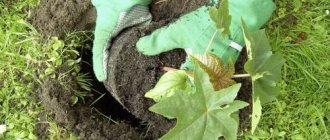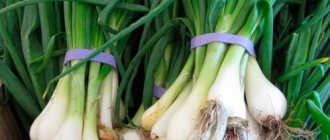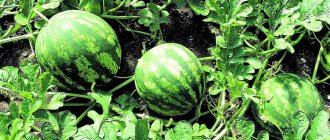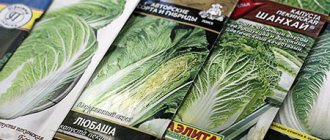Black radish is an unpretentious frost-resistant root crop, available for cultivation in any area and subject to long-term storage.
With proper care, the plant produces large, dense fruits with excellent taste, which allows the roots to be used for a long time in cooking for preparing vegetable dishes, as well as in folk medicine for the prevention and treatment of many diseases.
On our website you will find how to properly plant this healthy vegetable, favorable days for planting and how to care for it.
Popular types and varieties of radish
Radish is very diverse and can differ in shape, size, color (there are white, yellow, green, black, purple, red root vegetables). The crop is mainly divided into summer and winter radishes. Let's look at popular types and varieties of crops:
- White radish (Russian). A popular variety with a delicate taste and juicy. Most often consumed fresh. Popular varieties are: Delicacy, Sudarushka, Sirius, Summer Round White, Rex.
- Black radish (Bitter). It has many beneficial properties for humans and has a rich, bright taste. It is considered to be the most useful variety. Popular varieties of black radish: Winter long black, Divnaya, Lekar.
- Margelan radish (Chinese or Loba). It has a milder taste than the above varieties, is practically not bitter, is similar in taste to radishes, and is most often consumed fresh. Varieties: Margelanskaya, Ladushka, Elephant Fang, Sultan, Zarevo.
- Daikon (Japanese or Sweet radish, Bailobo). It also has a mild taste without bitterness, and is very healthy. The following popular varieties can be distinguished: Caesar, White Sun, Japanese White Long, Emperor, Ice Con, Dubinushka, Minowasi, Dragon.
- Green radish. Because of its pleasant, delicate taste, it is most often consumed raw; it contains many useful vitamins and minerals. Popular varieties: Green Goddess, Aelita.
Chinese radish (Lobo)
Lobo is also called Margelan radish. Root crops are round, cylindrical or elongated in shape. The color of the root vegetable can be light or dark green, pink-red, violet-lilac and other colors or shades.
Green radish (click on photo to enlarge).
Chinese radish (click on photo to enlarge).
A distinctive feature of this radish from other species is the dark green color of the upper part of the root crop. Its flesh varies from white to pink-red. The taste is not spicy, reminiscent of radishes, and can be considered neutral, which makes it possible to use lobo as food for liver diseases. Promotes rapid healing of purulent wounds and removes toxins and salts from the body.
The best varieties for growing : “Red Heart” (inside - like a watermelon, on top - green, without bitterness, perfectly stored all winter). Other varieties that can be recommended for cultivation are “Elephant Tusk”, “Pink Ring”, “Oktyabrskaya-1” and “Oktyabrskaya-2”, “Margelanskaya”.
When to plant radishes in open ground, in what month
The timing of planting radishes outdoors depends on the crop variety:
- To get early root crops in the summer-autumn period, you need to plant the seeds in the spring. In the spring, you can plant at the end of April - at the beginning of May. Approximate dates for sowing crop seeds in different regions: in the middle zone (Moscow region) - at the end of April (20th), at the beginning of May;
- in Siberia, the Urals, and the Leningrad region - in the first half of May (until the middle of the month).
- In the south (Krasnodar Territory) - in mid-April.
Radish is a cold-resistant plant, so its seeds germinate successfully at soil temperatures of about +3-5°C. At the same time, it can withstand frosts down to -3-4 degrees. Therefore, there is no need to be afraid of early sowing in spring.
By the way! The optimal growing temperature is no higher than 18 degrees Celsius. In hot conditions, root vegetables will grow coarser, smaller, and too pungent to taste.
Radish planting dates according to the lunar calendar 2021
It is believed that if you sow a crop at a certain time, you can achieve strong and good seedlings, and vice versa, if you sow on unfavorable days, the result will be worse. Therefore, thanks to the Lunar calendar 2021, the following dates for planting radishes in open ground can be distinguished:
- Favorable days: in April - 5, 6, 7, 9, 10, 11, 12, 13, 14, 18, 19, 20, 21, 22, 27, 28, 29, 30;
- in May - 2, 3, 4, 5, 6, 11, 12, 20, 21, 29, 30, 31;
- in June - 7, 8, 12, 13, 14;
- in July - 4, 6, 9, 10, 11, 13, 14, 15, 16, 27, 28, 29.
- in April - 8, 15, 16, 17, 23;
Black radish, plant description
- Black radish belongs to biennial herbaceous plants of the Brassica family and is one of the varieties of radish.
- Radish appeared in Rus' back in the 12th century; since then, this vegetable crop has been valued for its highly healing and beneficial properties.
- This variety of radish is distinguished by the black skin of the root crop and the bitterly pungent taste of the pulp.
- The root crop, weighing from 200 to 600 g, has a round shape and is formed in the first year of planting (after 3-4 months). The radish pulp is white, juicy and dense.
- The leaves of the vegetable are pinnately divided and green in color. Radish seeds are small, dark in color, round in shape, and ripen in the second year after planting.
- The plant is characterized by a high level of cold resistance, ease of care and high yield.
- Black radish has varieties of early, middle and late sowing dates. The vegetable is usually grown by seed in open ground.
- Black winter radish is one of the most famous mid-season varieties, ripening in about 3.5 months. The winter variety is especially rich in ascorbic acid and is perfectly preserved throughout the winter.
Black radish, beneficial properties
- Black radish has long been famous for its medicinal properties. The root vegetable contains many useful substances: micro and macroelements (potassium, sulfur, calcium, magnesium), mineral salts, proteins, sugars, essential oil, etc.
- Eating radish allows you to cope with many problems in the human body. It improves appetite and normalizes intestinal function; helps with persistent coughs (colds) and the treatment of radiculitis; calms the nervous system and speeds up metabolism.
- Grated black radish stimulates the healing of wounds, especially purulent ones; irritates and strengthens hair follicles. In addition, its juice helps eliminate cholesterol and is a proven choleretic agent.
- Radish juice is widely used for diseases of the cardiovascular system, gastrointestinal tract, and respiratory system. When consuming the juice, it is important to consult a doctor because in large quantities, radish is irritating and may cause harm. There are also a number of contraindications for using the root vegetable internally (for example, pregnancy, stomach ulcer or acute period of any disease).
- In addition to its proven medicinal properties, radish is a popular product in cooking. The piquant taste and tart aroma allow the vegetable to be used for preparing a variety of salads and snacks.
Features of growing black radish
- Experienced vegetable growers recommend slightly shaking the root crop while growing a crop. This technique allows you to slow down the development of lateral roots so that the main tap root receives maximum nutrition. After this, the radish grows juicy, dense and large.
- Radish is prone to the formation of shoots, which negatively affects the quality of root crops. To avoid bolting, you should constantly maintain a moist soil environment, sow seeds after all frosts (or cover the bed with film) and choose varieties that are resistant to the formation of flower stems (arrows). Thickened radish plantings also provoke bolting.
- The best predecessors of black radish are the following vegetable crops: potatoes, onions, lettuce, dill, peppers, zucchini, legumes, cucumbers, pumpkin, eggplant. Under no circumstances should radishes be sown after cruciferous crops, as they have common pests and the same diseases.
- If there is not enough land area, radishes can be sown with other vegetables, for example, onions, potatoes or tomatoes.
Where to plant radishes: choosing a place and soil for the garden bed
The best radish crop can be grown only on fertile, loose, moderate, moist loamy soil, which is well fertilized with humus. Also, the soil must have neutral acidity.
At the same time, in heavy, too dense soil, root crops grow poorly and will not be able to please the summer resident with a good harvest. And in a waterlogged bed (for example, with a high groundwater table), the root crops rot. You cannot plant radishes in an area with acidic soil, otherwise the plants will get sick and the root crops will quickly deteriorate.
You can sow root crop seeds after various crops in the garden. The best predecessors for radish: legumes (peas, beans), tomatoes, potatoes, cucumbers, pumpkin, zucchini, greens.
Bad predecessors are all representatives of the cruciferous family (cabbage, radishes, rutabaga, turnips, the radish itself). After all, they have the same diseases and pests, and they also take the same nutrients from the soil.
Good radish neighbors for planting together: cucumbers, carrots, potatoes, onions, tomatoes, beets, spinach, legumes, melon, pumpkin, parsnips, fennel, corn.
Harvesting and storage
Early and mid-season varieties are harvested in mid-summer. Late varieties are harvested in October, in dry weather, before the first frost.
Depending on the region, harvesting takes place at different times:
- Middle zone - end of August;
- Ural - at the end of September;
- Siberia - early October.
Do not delay harvesting. Frosts and rains can destroy the entire crop.
Ripe root crops are pulled out of the ground. Cut off the top green part, leaving about 2 cm of petioles and roots. Ventilate to dry the soil on them. Fruits that are not damaged are suitable for storage.
Root vegetables are stored in the refrigerator, placed in a plastic bag with holes for ventilation. They also use a cool and dark cellar. The fruits are placed in wooden boxes, sprinkled with ash or sawdust. The temperature in the cellar should be 2-3°C, humidity should not exceed 80-85%. At higher temperatures, root crops germinate.
How to prepare the soil for planting radishes
A few weeks before planting radishes, it is necessary to prepare the site to make the place most suitable for growing the crop. Thanks to this, the harvest will be of higher quality.
It is necessary to dig up the soil onto the bayonet of a shovel (to a depth of about 35 centimeters). Mineral fertilizers are applied during digging: urea (10 grams), superphosphate (30 g), potassium chloride (15 g) per 1 square meter.
It is also important to add organic fertilizers - humus (10 kilograms per square meter) before digging. At the same time, it is advisable to fertilize the soil with organic matter in the fall. It is also useful to add wood ash (200 grams per square meter).
As mentioned above, radish does not like acidic soil (you can’t even dream of a good harvest on such soil). Therefore, acidic soil must be limed, for example, dolomite flour or a special soil deoxidizer, which can be bought at a garden store.
Preparing for landing
The culture is unpretentious and does not require special care. Creating favorable growing conditions will improve the quality of the crop. The root vegetables will be large in size with a pronounced aroma and high taste.
Selecting a location
An open place with access to sunlight throughout the day is considered favorable for vegetable growth. If the area is partially shaded, then the lack of light leads to smaller fruits. The seating area may be exposed to wind. The plant tolerates drafts well.
Favorable predecessors are:
- potato;
- tomato;
- cucumbers;
- legumes;
- carrot.
Unfavorable predecessors:
- cabbage;
- radish;
- turnip;
- swede.
Failure to follow crop rotation rules leads to radish diseases. The planting site will have to be frequently treated with insecticides.
You can plant onions between the rows of black radishes. It will repel slugs and other pests.
Soil preparation
The culture grows well in any soil, except acidified or saline. Loam or gray soil is most suitable.
Soil requirement:
- loose, highly breathable and absorbs water;
- neutral alkaline environment, slightly alkaline and acidic are also suitable.
Adding lime in a proportion of 200 g per 1 square meter will help reduce the acidity of the soil. m or adding crushed eggshells, chalk or dolomite flour.
You should not choose a place for planting if the groundwater lies at a level of 0.5 m from the surface of the earth.
The soil begins to be prepared in the fall. The area is cleared of leaves, branches and grass. They dig with a shovel on a bayonet.
Fertilizers must be added. Wood ash is considered universal, suitable for any type of soil. It is used at the rate of 0.5 liters per 1 sq. m. If the soil is poor, add organic matter. River sand is added to the clayey one, making it lighter.
Fertilizers used in spring:
- Mineral . Superphosphate – 10-12 g per 1 sq. m, potassium – 6-8 g per 1 sq. m and urea.
- Organic . Compost or humus - 2-3 kg per 1 sq. m.
Manure cannot be used. It is a favorable breeding ground for many pests, insects and bacteria that cause diseases in plants. In addition, the fruits lose their aroma and taste.
If you need to add lime to the soil to reduce acidity, this is done 2 weeks before using the main fertilizers.
Seed treatment
The crop is propagated by seed. Black radish does not tolerate transplantation well, there is a possibility of damaging the root. This will prevent the full formation of the fetus.
Seed preparation includes the following steps:
- Calibration Select by hand the largest seeds with an even and intact shell. Small, empty and broken copies should be thrown away.
- Place the selected seeds in the saline solution for 10-15 minutes. It is prepared at the rate of 1 tbsp. spoon per glass of water. Remove floating seeds. This method will help remove empty shells that were missed during the previous inspection.
- Take a sieve and wash the seed material.
- Place the seeds for a day in a weak solution of manganese. It has a disinfecting effect and prevents the occurrence of diseases in the future at all stages of the growing season.
- Wrap the seeds in damp gauze, which, in addition to water, can be moistened with a growth stimulator. In this state, they are saturated with moisture to improve germination.
Step-by-step instructions for planting radish seeds in open ground
Planting black, white, green and any other radishes is very simple, and even a novice gardener should not have any difficulties when following all the steps. After you have waited for the optimal timing and prepared the bed, you can begin the event. The following step-by-step diagram will help you sow radish seeds correctly in open ground:
- Step 1: To reduce the risk of plant infection, it is useful to disinfect the seeds. For example, you can treat it in a solution of the fungicide Fitosporin (prepare the solution and soak according to the instructions) or Chlorhexidine 0.05% (30 minutes). After soaking, you need to rinse the seeds with clean water and dry them until they become free-flowing.
- Step 2: Make grooves. The depth of the row is 2 centimeters, the distance between the furrows is 30-40 cm.
- Step 3: Water the rows generously with warm water, wait a little until the moisture is completely absorbed.
- Step 4: Sow radish seeds. The optimal distance between seeds is 15-20 cm. But it is recommended to plant seeds more often (with an interval of about 5 cm or less), and then thin out the seedlings , leaving the strongest and best plants. Or you can plant 3-4 seeds in nests at a distance of 15 cm (and then also thin out).
- Step 5: Fill the seed furrow with soil.
- Step 6: Firm the soil in the rows by hand.
- Step 7: Cover the bed with agrofibre or film until shoots emerge.
Reviews
★★★★★
Anastasia, 48 years old, Penza. I love radishes, so I decided to grow them at the dacha.
I didn't think it would be so easy to take care of. She reaped a good harvest. ★★★★★
Natalya, 53 years old, Ural. I have been growing this species for several years now.
I use a greenhouse to protect it from severe frosts. It is very easy to soak the seeds and plant them in the ground. Due to the greenhouse conditions, there are not many weeds, so I do not weed as often. ★★★★★
Mikhail, 48 years old, Voronezh. I am very pleased with the black radish.
The fruits are large and juicy. This is my second year growing it and I haven’t encountered any diseases. Hide
Add your review
Black radish is suitable for growing in any climatic zone of our country. Grows in open ground and does not require picking or replanting. It is not difficult to care for the crop; you just need to follow the watering schedule and weed the weeds on time. After 2-3 months, a rich harvest is harvested in the form of strong and juicy root crops.
0
0
Copy link
Caring for radish and rules for growing in open ground
We can definitely say that radish is a very unpretentious and not demanding crop, so growing it in general is not a difficult undertaking.
Immediately after planting radish seeds in open ground, you need to wait for germination and concentrate on care:
- After the seedlings sprout in the garden bed, it is necessary to remove the cover (film or agrofibre, spunbond).
- After emergence, in order to prevent pests (in particular the dangerous cruciferous flea beetle), you can dust the plants with a mixture of wood ash and tobacco dust.
- Radish is a moisture-loving root vegetable. The culture needs timely and regular watering. The crop does not tolerate moisture deficiency well, which is why the root crops grow small in size and bitter in taste. As a rule, it should be watered once every 7 days. The watering rate is about 10 liters per 1 square meter of bed. It is necessary to maintain stable, moderate soil moisture and do not allow the soil to dry out.
Note! At the same time, watering should be regular; if, after a drought, you pour plenty of water into the garden bed, the root crops may crack.
- If you did private sowing, then you need to thin out the radish seedlings . The first thinning is carried out when 1-2 leaves appear, it is necessary to remove the weakest and smallest plants, there should be a gap of 5-6 cm between the shoots. The second thinning is carried out 20-30 days after the first, this time it is necessary to leave a distance between the plants 10-15 cm (the strongest plants are left). If you do not thin out the radish in time, then flower stalks will grow on many plants, and there can be no talk of any harvest of root crops.
- The culture responds well to fertilizing. In this case, it is useful to carry out the care procedure if you did not apply fertilizers when preparing the bed for sowing seeds. It is necessary to use mineral fertilizers (organic matter has a bad effect on the keeping quality and quality of the crop). It is enough to make 1-2 feedings (the first - when 3-4 leaves appear, the second - 1 month after the first time). For example, you can fertilize with the following solution of mineral fertilizers: in a 10-liter bucket of warm water, well dissolve superphosphate (20 g), urea (10 g), and potassium chloride (10 g). You can feed only after watering with plain water.
- to loosen the soil between the rows approximately once every 14 days Loosening can be combined with weeding .
You can harvest spring radishes in the summer, when the root crops reach 4-6 centimeters in diameter. At the same time, they can be removed selectively, in several stages. Late varieties for winter storage should be harvested in the fall before frost.
Main diseases and pests
The following diseases and pests are considered dangerous to crops:
| Disease/pest | Manifestation | Treatment |
| Powdery mildew | A light coating forms on the leaves. Gradually it darkens to brown. Leaves wither and die. | Topaz. It is diluted in water and sprayed. |
| Kila | It affects the roots, forming growths on them. Gradually the foliage dries out. | Wood ash and bleach. The soil is disinfected. |
| Root rot | Dark spots appear at the base of the fruit and on the petioles of the leaves, which lead to softening of parts of the plant. Additionally, mold forms. There is a specific smell. | Trichodermin. Kills fungus. Wood ash mixed with chalk in a 1:1 ratio. The resulting powder is used to treat the affected parts of the plant. |
| Slugs | Light color. They hide during the day, and at night they eat the tops and protruding parts of the root crop. If they attack young plants, they can completely destroy them. | Thunderstorm, Slug Eater. Mustard or an infusion of red hot pepper is diluted in water and sprayed on plants and soil. |
| Cabbage moth | The insect is light brown in color. It lays larvae on leaves, the sap of which they feed on. | The larvae live on the back side of the leaf. They need to be removed and the sheet wiped with soapy water. In case of severe damage to the plant, insecticides are used. |
| White butterfly | Lays eggs in the soil. The hatched caterpillars eat the leaves. The leaf plate curls and oblong-shaped holes appear in it. | Solution: mustard, red pepper and salt. Leave for more than a day and spray all parts of the plant. Add wood ash with cinnamon or saffron to the soil. |
Remember that many diseases and pests can appear due to high humidity around the plant and untimely removal of weeds.
Rules of care.
Thinning. When planted in rows, radish seedlings are thinned out in the phase of full development of the first pair of true (not cotyledon) leaves. Excess plants are pulled out in such a way that a distance of 9-10 cm is maintained between the specimens remaining in the ground.
With the nest sowing method, the first thinning is carried out on the 10th day from the date of emergence, the second - as soon as the rudiments of root crops begin to form, the third - when they reach a thickness of 6-7 mm.
Which variety should you prefer?
As of the end of 2021, the State Register lists 28 varieties of black and white radish. In fact, there are much more of them. To choose the right varieties of black and white radish, you need to take into account the region where the crop will be grown and the timing of its consumption.
Selection of varieties depending on region
Radish varieties included in the State Register are recommended for cultivation throughout Russia. They are simply planted a little earlier or later to adapt to the local climate.
One could write that in the North they grow the most frost-resistant varieties, and for the south they choose those that are not prone to bolting. But in fact, round white and black radishes give a good harvest everywhere; you need to dig them up, regardless of the region, before the thermometer shows a negative temperature. And in any case, the peduncle will form when there is more daylight than night, or in extreme heat, unlike radishes, which have varieties that are resistant to bolting.
Conclusion! The choice of variety does not depend on the growing region. The crop is adapted to local conditions by “playing” with planting dates.
Selection of varieties according to ripening and storage periods
For fresh consumption, white radish varieties are chosen, which are planted in early spring. They are not stored and are not suitable for processing, but they have a milder taste than winter ones. It is recommended to grow the following early varieties:
- Agate with a white conical root weighing up to 400 g, ripening – 50-60 days;
- A delicacy with a convex head weighing up to 50 g and ripening in 38-40 days;
- Bianca with small (up to 45 g) flattened heads, ripening - 40-42 days;
- Mayskaya - a white, flattened root crop, weighing up to 100 g, ripening - 55-65 days;
- Munich Beer - a variety with an oval white root crop weighing up to 400 g, ripening in 55-60 days;
- Sirius is the newest high-yielding variety, with a conical white root weighing up to 65 g and ready for harvest 38-40 days after germination.
There are varieties that can be stored for a month or a little longer. They are considered late autumn, but not because they are planted in the summer, but because of their shelf life - they are eaten fresh or kept until the beginning of winter. Such radishes will not be stored longer. The best varieties:
- Astronomer with pink skin and conical roots weighing from 75 to 330 g, ripening in 65 days;
- Autumn Luck - a variety that ripens in 72-75 days, with rounded white root crops and weighing up to 270 g;
- Svakha with a flattened white root crop, weighing up to 150 g, ripening period - 52-55 days.
Radish varieties for winter storage usually (but not always) are distinguished by black skin, pronounced bitterness and the highest content of nutrients. The longer their ripening period, the better the keeping quality of root crops. The following varieties can be recommended for cultivation:
- Uncle Chernomor is a new variety that ripens in 55-60 days with a flat-round black root, white pulp, moderately pungent taste and weight 200-220 g;
- Winter round white - an old, proven variety with excellent keeping quality, ripening in 80-100 days, with a round head, white skin and a sharp taste;
- Winter round black - perhaps the most famous old variety, ripens in 70-110 days, with black peel and white pulp, round root crop weighing 250-550 g, sharp taste, long shelf life and high content of nutrients;
- Misato Green is a French winter variety, distinguished by good taste, white-green peel and triangular root crop weighing 350-450 g, ripening - 50 days;
- Nochka is considered one of the most delicious winter varieties, ripens in 68-75 days, rounded black root crop, up to 220 g;
- Cylinder stands out among other varieties due to its long, conical black root crop, similar in shape to daikon, ripens in 62-73 days, weighs up to 210 g.
Brief description and characteristics of culture
Radish is a member of the cabbage family. Of its several varieties - oilseed, daikon, Margelan, sweet - round black winter radish is considered the most healing, and therefore the most popular. Its beneficial properties and simplicity of cultivation technology determine the long-standing popularity of the vegetable, which has been cultivated in our country since the 12th century.
The plant has a two-year growing season: in the first year it produces roots that are used as food, in the second year it produces seeds. The vegetable is exceptionally cold-resistant; root crops are harvested just before frost. The only point that requires special attention when growing it is planting time.











